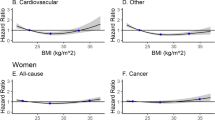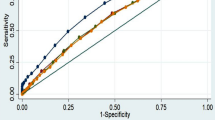Abstract
OBJECTIVE:
Waist circumference is directly related to all-cause mortality when adjusted for body mass index (BMI). Body fat and fat-free body mass, when mutually adjusted, show with increasing values an increasing and decreasing relation to all-cause mortality. We investigated the association of waist circumference and body composition (body fat and fat-free mass), mutually adjusted, to all-cause mortality.
DESIGN:
A Danish prospective cohort study with a median follow-up period of 5.8 y.
SUBJECTS:
In all, 27 178 men and 29 875 women, born in Denmark, aged 50–64 y, and without diagnosis of cancer at the time of invitation.
MEASUREMENTS:
Waist circumference and body composition estimated from impedance measurements. Cox's regression models were used to estimate the mortality rate ratios (RR).
RESULTS:
Waist circumference was strongly associated with all-cause mortality after adjustment for body composition; the mortality RR was 1.36 (95% confidence intervals (CI): 1.22–1.52) times higher per 10% larger waist circumference among men and 1.30 (95% CI: 1.17–1.44) times higher among women. Adjustment for waist circumference eliminated the association between high values of the body fat mass index (BFMI) and all-cause mortality. The association between fat-free mass index (FFMI) and mortality remained unaltered.
CONCLUSION:
Waist circumference accounted for the mortality risk associated with excess body fat and not fat-free mass. Waist circumference remained strongly and directly associated with all-cause mortality when adjusted for total body fat in middle-aged men and women, suggesting that the increased mortality risk related to excess body fat is mainly due to abdominal adiposity.
This is a preview of subscription content, access via your institution
Access options
Subscribe to this journal
Receive 12 print issues and online access
$259.00 per year
only $21.58 per issue
Buy this article
- Purchase on Springer Link
- Instant access to full article PDF
Prices may be subject to local taxes which are calculated during checkout

Similar content being viewed by others
References
The Scottish Intercollegiate Guidelines Network. Obesity in Scotland. Integrating Prevention with Weight Management: A National Clinical Guideline Recommended for use in Scotland by the Scottish Intercollegiate Guidelines Network, Pilot edn. Scottish Intercollegiate Guideline Network (SIGN): Edinburgh; 1996.
Clinical Guidelines on the Identification, Evaluation, and Treatment of Overweight and Obesity in Adults: The Evidence Report. Obes Res 1998; 6: S51–S210.
WHO. Obesity: Preventing and Managing the Global Epidemic, Report of a WHO Consultation, Technical Reports Series, No. 894. World Health Organization: Geneva; 2000.
Molarius A, Seidell JC . Selection of anthropometric indicators for classification of abdominal fatness—a critical review. Int J Obes Relat Metab Disord 1998; 22: 719–727.
Seidell JC, Kahn HS, Williamson DF, Lissner L, Valdez R . Report from a Centers for Disease Control and Prevention Workshop on use of adult anthropometry for public health and primary health care. Am J Clin Nutr 2001; 73: 123–126.
Janssen I, Heymsfield SB, Allison DB, Kotler DP, Ross R . Body mass index and waist circumference independently contribute to the prediction of nonabdominal, abdominal subcutaneous, and visceral fat. Am J Clin Nutr 2002; 75: 683–688.
Janssen I, Katzmarzyk PT, Ross R . Body mass index, waist circumference, and health risk: evidence in support of current National Institutes of Health guidelines. Arch Intern Med 2002; 162: 2074–2079.
Bigaard J, Tjønneland A, Thomsen BL, Overvad K, Heitmann BL, Sørensen TIA . Waist circumference, BMI, smoking, and mortality in middle-aged men and women. Obes Res 2003; 11: 895–903.
Bigaard J, Frederiksen K, Tjønneland A, Thomsen BL, Overvad K, Heitmann BL, Sørensen TIA . Body fat and fat-free mass and all-cause mortality. Obes Res 2004; 12: 1042–1049.
Heitmann BL . Prediction of body water and fat in adult Danes from measurement of electrical impedance: A validation study. Int J Obes Relat Metab Disord 1990; 14: 789–802.
Baumgartner RN, Heymsfield SB, Roche AF . Human body composition and the epidemiology of chronic disease. Obes Res 1995; 3: 73–95.
VanItallie TB, Yang MU, Heymsfield SB, Funk RC, Boileau RA . Height-normalized indices of the body's fat-free mass and fat mass: potentially useful indicators of nutritional status. Am J Clin Nutr 1990; 52: 953–959.
Andersen TF, Madsen M, Jørgensen J, Mellemkjær L, Olsen JH . The Danish National Hospital Register. A valuable source of data for modern health sciences. Dan Med Bull 1999; 46: 263–268.
Korn EL, Graubard BI, Midthune D . Time-to-event analysis of longitudinal follow-up of a survey: choice of the time-scale. Am J Epidemiol 1997; 145: 72–80.
Greenland S . Dose-response and trend analysis in epidemiology: alternatives to categorical analysis. Epidemiology 1995; 6: 356–365.
Tjønneland A, Overvad OK . Diet, cancer and health—a population study and establishment of a biological bank in Denmark (in Danish). Ugeskr Laeger 2000; 162: 350–354.
Baumgartner RN . Body composition in elderly persons: a critical review of needs and methods. Prog Food Nutr Sci 1993; 17: 223–260.
Heitmann BL . Impedance: a valid method in assessment of body composition? Eur J Clin Nutr 1994; 48: 228–240.
Roubenoff R . Applications of bioelectrical impedance analysis for body composition to epidemiologic studies. Am J Clin Nutr 1996; 64: 459S–462S.
Heitmann BL . Evaluation of body fat estimated from body mass index, skinfolds and impedance. A comparative study. Eur J Clin Nutr 1990; 44: 831–837.
Han TS, Lean ME . Bioelectrical impedance analysis in nutritional research. Nutrition 1998; 14: 707–708.
Han TS, Carter R, Currall JE, Lean ME . The influence of fat free mass on prediction of densitometric body composition by bioelectrical impedance analysis and by anthropometry. Eur J Clin Nutr 1996; 50: 542–548.
Heitmann BL, Erikson H, Ellsinger BM, Mikkelsen KL, Larsson B . Mortality associated with body fat, fat free mass and body mass index among 60-year-old Swedish men—a 22 year follow-up. The study of men born in 1913. Int J Obes Relat Metab Disord 2000; 24: 33–37.
Lissner L, Bjorkelund C, Heitmann BL, Seidell JC, Bengtsson C . Larger hip circumference independently predicts health and longevity in a Swedish female cohort. Obes Res 2001; 9: 644–646.
Bigaard J, Frederiksen K, Tjønneland A, Thomsen BL, Overvad K, Heitmann BL, Sørensen TIA . Waist and hip circumference and all-cause mortality: usefulness of the waist-to-hip ratio? Int J Obes Relat Metab Disord 2004; 28: 741–747.
Mikkelsen KL, Heitmann BL, Keiding N, Sørensen TIA . Independent effects of stable and changing body weight on total mortality. Epidemiology 1999; 10: 671–678.
Sørensen TIA . Weight loss causes increased mortality: pros. Obes Rev 2003; 4: 3–7.
Acknowledgements
The study was financially supported by grants from The Danish Research Councils, ref. no. 9801264, and The Danish Cancer Society. We thank programmer Katja Boll for preparation of the data set and Jytte Fogh Larsen for collection of data. The Danish Epidemiology Science Centre is supported by the Danish National Research Foundation.
Author information
Authors and Affiliations
Corresponding author
Rights and permissions
About this article
Cite this article
Bigaard, J., Frederiksen, K., Tjønneland, A. et al. Waist circumference and body composition in relation to all-cause mortality in middle-aged men and women. Int J Obes 29, 778–784 (2005). https://doi.org/10.1038/sj.ijo.0802976
Received:
Revised:
Accepted:
Published:
Issue Date:
DOI: https://doi.org/10.1038/sj.ijo.0802976
Keywords
This article is cited by
-
Übergewicht und Adipositas bei Erwachsenen: allgemeine Behandlungsgrundsätze und konservatives Management
Wiener klinische Wochenschrift (2023)
-
Body fat and risk of all-cause mortality: a systematic review and dose-response meta-analysis of prospective cohort studies
International Journal of Obesity (2022)
-
Relationship between body image, anxiety, food-specific inhibitory control, and emotional eating in young women with abdominal obesity: a comparative cross-sectional study
Archives of Public Health (2021)
-
Levels and changes in body mass index decomposed into fat and fat-free mass index: relation to long-term all-cause mortality in the general population
International Journal of Obesity (2020)
-
BMI is associated with FEV1 decline in chronic obstructive pulmonary disease: a meta-analysis of clinical trials
Respiratory Research (2019)



